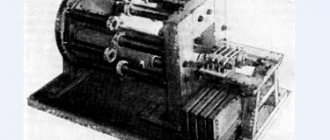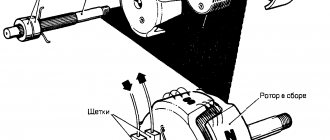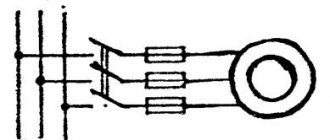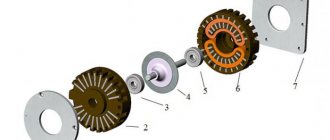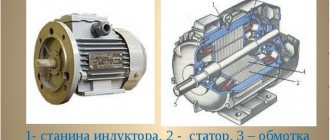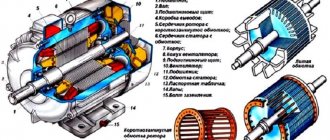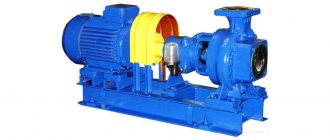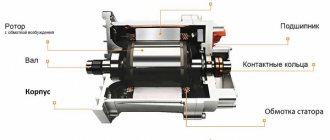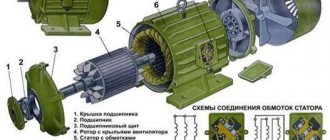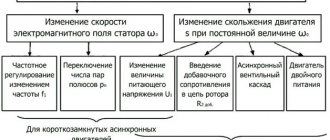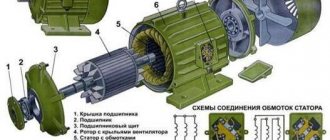The commutator unit of the electric motor is necessary to transmit electricity to the armature windings. Since the armature produces a rotational movement during operation, transmission is carried out through a special contact. To organize a moving contact in all household and industrial motors, metal plates are not used. This is due to high speeds, at which metal-to-metal friction would produce additional heating of the working surface and rapid depletion of the collector. Therefore, graphite or coal was chosen as the contact. It got the name - electric brush.
Motor brushes
A sliding contact, designed for supplying and discharging electricity to collectors or ring contacts of all types of electrical machines (electric motors and generators), is called an electric brush.
Electric motor brushes are produced both with and without metal conductors. The wire is secured in the brush by flaring, pressing, or soldering. Brush current conductors come in the following brands:
- MPShch – a special type of stranded wire, made of copper wire;
- ПШ – flexible type of copper wire weave;
- PShchS is a universal wire with increased flexibility.
Contact tips are provided on the supply wire. Using them, the wire is secured with a brush holder bolt. Tips come in fork, flag, double and plate types.
Brush design.
The design of the brush indicates the location of the current-carrying leads on the body of the brush, their number, as well as the presence or absence of various slots for attaching the brush.
Typical designs of electric contact brushes are shown in the table.
| General view of the brush | Brush type | Brief description and purpose of the brush. |
| K1 | Rectangular brush, unreinforced. Used in radial brush holders with springs of various designs | |
| K1-1 | The brush is rectangular with one wire on the top surface along the axis of the brush. Used in radial brush holders with springs of various designs | |
| K1-2 | The brush is rectangular with one wire on the top surface, offset from the axis of the brush. Used in radial brush holders with springs of various designs | |
| K1-3 | The brush is rectangular with two wires on the top surface, symmetrical relative to the axis of the brush. Used in radial brush holders with springs of various designs | |
| K1-4 | The brush is rectangular with one wire on the smaller side edge. Used in radial brush holders with springs of various designs | |
| K1-5 | The brush is rectangular with one wire on the larger side edge. Used in radial brush holders with springs of various designs | |
| K1-6 | The brush is rectangular with two wires on the side. Used in radial brush holders with springs of various designs | |
| K1-7* | The brush is rectangular with two wires on the top surface, offset from the axis of the brush. Used in radial brush holders with springs of various designs | |
| K1-8* | The brush is rectangular with four wires on the top surface, symmetrical relative to the axis of the brush. Used in radial brush holders with springs of various designs | |
| K2 | Brush with beveled contact surface. Used in reactive brush holders | |
| K2-1 | A brush with a beveled contact surface and one wire on the upper surface of the brush along the axis of the brush. Used in reactive brush holders | |
| K2-2 | A brush with a beveled contact surface and one wire on the upper surface of the brush, offset from the axis of the brush. Used in reactive brush holders | |
| K2-3 | A brush with a beveled contact surface and two wires on the upper surface of the brush, symmetrical relative to the axis of the brush. Used in reactive brush holders | |
| K2-7* | A brush with a beveled contact surface and two wires on the upper surface, offset from the axis of the brush. Used in reactive brush holders | |
| K2-8* | A brush with a beveled contact surface and four wires on the top surface, symmetrical relative to the axis of the brush. Used in reactive brush holders | |
| K3-3 | A brush with beveled contact and top surfaces and two wires on the top surface. Used in reactive brush holders | |
| K3-5 | A brush with beveled contact and top surfaces with a wire on the side edge. Used in reactive brush holders | |
| K3-8* | Brush with beveled contact and top surfaces and four wires on the top surface. Used in reactive brush holders | |
| K4-2 | The brush is rectangular with a bevel on the top surface and one wire on the bevel. Used in radial brush holders with springs of various designs | |
| K5-2 | A brush with a beveled contact surface and one wire on the beveled top surface. Used in reactive brush holders | |
| K6-3 | The brush is rectangular with bevels on the top surface and two wires on the bevels. Used in radial brush holders with springs of various designs | |
| K6-8* | The brush is rectangular with bevels on the top surface and four wires on the bevels. Used in radial brush holders | |
| K8 | The brush is rectangular with a groove on the top surface. Used in radial brush holders | |
| K8-2 | The brush is rectangular with a groove and one wire on the top surface, offset from the axis of the brush. Used in radial brush holders with flat band spring | |
| K8-3 | The brush is rectangular with a groove and two wires on the top surface, symmetrical relative to the axis of the brush. Used in radial brush holders with flat band spring | |
| K8-4 | The brush is rectangular with a groove on the top surface and one wire on the smaller side edge. Used in radial brush holders with flat band spring | |
| K8-5 | The brush is rectangular with a groove on the top surface and a wire on the larger side edge. Used in radial brush holders with flat band spring | |
| K8-8* | The brush is rectangular with a groove and four wires on the top surface, symmetrical relative to the axis of the brush. Used in radial brush holders with flat band spring | |
| K10-4 | A brush with a beveled contact surface, a groove on the top surface and one wire on the side edge. Used in reactive brush holders | |
| K11 | A brush with a beveled contact surface, a groove on the top surface and one wire on the side edge. Used in radial brush holders | |
| K11-3 | A brush with a beveled contact surface, a beveled groove and two wires on the top surface, symmetrical relative to the axis of the brush. Used in reactive brush holders | |
| K11-4 | A brush with a beveled contact surface, a beveled groove on the top surface and one wire on the side edge. Used in reactive brush holders | |
| K11-8 | A brush with a beveled contact surface, a beveled groove on the top surface and four wires on the top surface. Used in reactive brush holders | |
| K12-3 | Rectangular brush with a groove and two wires on the top surface, with a rubber pad. Used in radial brush holders | |
| K12-8* | Rectangular brush with a groove and four wires on the top surface, with a rubber pad. Used in radial brush holders | |
| K13-2 | The brush is rectangular with a groove on the top surface with a bevel and one wire on the bevel. Used in radial brush holders with flat band spring | |
| K14 | The brush is rectangular with a head on the top surface. Used in radial brush holders with spiral wire spring | |
| K14-1 | The brush is rectangular with a head on the top surface and one wire on the head. Used in radial brush holders with spiral wire spring | |
| K14-5 | The brush is rectangular with a head on the top surface and one wire on the side. Used in radial brush holders with spiral wire spring | |
| K15-6 | Brush with contact and top surfaces, with a beveled groove and two wires in the side face. Used in reactive brush holders | |
| K16-2 | A brush with a beveled contact surface, two bevels on the top surface and one wire on the bevel. Used in reactive brush holders | |
| K17-2 | A brush with a beveled contact surface, two bevels on the top surface and one wire in the side bevel. Used in reactive brush holders | |
| K17-3 | A brush with a beveled contact surface, three bevels on the top surface and two wires in the side bevels. Used in reactive brush holders | |
| K18-2 | A brush with a beveled contact surface, two bevels, a beveled groove on the top surface and one wire on the bevel. Used in reactive brush holders | |
| K19-2 | A brush with a beveled contact surface, three bevels, a beveled groove on the top surface and one wire on the bevel. Used in reactive brush holders | |
| K20-3 | The brush is split with bevels on the contact and top surfaces, a pressed-in cover and two wires offset relative to the axis of the brush. Used in reactive brush holders | |
| K20-8 | The brush is split with bevels on the contact and top surfaces, a pressed-in patch and four wires. Used in reactive brush holders | |
| K21-2 | Brush of complex design with one wire. Used in radial brush holders | |
| K21-3 | Brush of complex design with two wires. Used in radial brush holders | |
| K22-6 | The brush is rectangular with two bevels, a groove on the top surface and two wires on the side. Used in radial brush holders with flat band spring | |
| K23-1 | Trapezoidal brush with one wire. Used in radial brush holders | |
| K23-8 | Trapezoidal brush with four wires. Used in radial brush holders | |
| K24-2 | A brush with bevels on the contact and top surfaces, a beveled groove and one wire on the bevel. Used in reactive brush holders | |
| K27-3 | Trapezoidal brush with two wires. Used in radial brush holders | |
| K27-8 | Trapezoidal brush with four wires. Used in radial brush holders | |
| K28-3 | A brush with a complex contact surface and two wires symmetrical relative to the axis of the brush. Used in radial brush holders |
Types of brushes
There are several classes of brushes that satisfy different switching conditions:
- Graphite brushes. They are made on the basis of graphite with the addition of filler in the form of soot and other substances. Brushes are intended for light commutation in generators and engines. The grades EG61A and G20 are produced.
- Carbon-graphite type. Low strength brushes for light mechanical loads. Brands G21, G22.
- Electrographite type. Brushes of increased mechanical strength, saturated with carbon. Perform switching of medium complexity. Withstand high current loads. There are brands EG2A, EG74, EG14, EG4, EG841.
- Metal-graphite type (copper-graphite brushes for electric motors). The main component of the brush is copper, tin and graphite powder. They come with different fillers. The brushes are highly durable and do not allow gas or liquid to pass through. Applicable in high and medium complexity switching conditions. Ensure the functioning of low voltage generators. The brands are MG, MGS, MGS 5, MGS 20, MGS 51, MGSOA, MGSO, MGSO1M, M1A, M1.
The described brush contacts are applicable in industry; brushes of the G33MI, G33, G30, G31 brands are produced for household equipment.
Metal-graphite brushes
Metal-graphite brushes of brands 611OM, M1A, MG, MG4, MGS5, MGS20, MGSO, MGSO1M, MGSOA, M1A, MGS51 and others are used in electrical machines, generators, current converters, asynchronous motors, starters, low-voltage machines with high current density, gearmotors , actuators for road transport, etc.
| Brand | Hardness, kPa×104 | Electrical resistivity, µOhm×m | Nominal current density, A/cm2 | Maximum permissible linear speed, m/s | Transient voltage drop across a pair of brushes, V |
| 611ОМ | 6-12 | 8-28 | 15 | 40 | 0,7-1,7 |
| M1A | 8-25 | 2-8 | 12 | 60 | 0,8-2,0 |
| MG | 4-14 | no more than 12 | 30 | 30 | no more than 0.4 |
| MG4 | 10-22 | no more than 1.3 | 24 | 30 | no more than 1.6 |
| MGS5 | 6-20 | 2-15 | 45 | 16 | 0,7-1,9 |
| MGS20 | 6-25 | no more than 0.4 | 120 | 15 | 0,3-1,0 |
| MGSO | 6-20 | 2-15 | 30 | 30 | no more than 0.35 |
| MGSO1M | 6-20 | no more than 0.8 | 80 | 15 | 0,1-0,5 |
| MGSOA | 14-45 | no more than 0.3 | 100 | 15 | 0,1-0,45 |
| M1A | 8-25 | 2-8 | 12 | 33 | 0,8-2,0 |
| MGS51 | 6-20 | 2-13 | 80 | 15 | 1,2-2,5 |
Brush Contact Selection
The most important thing when selecting electric motor brushes is to know the parameters of the used brushes. In addition to geometric dimensions, the new brush must match the grade of graphite, type and cross-section of wire. It is not necessary to take the same brand as the original, but the hardness of the electric motor brush and operating modes must match. The thickness of the wire should not be less than the original, and the flexibility should be consistent. Main mistakes when selecting a brush contact:
- Installing a harder graphite contact where softer ones were used. The result can be rapid wear of the manifold.
- Installation of “universal” brushes everywhere. This may interfere with the operation of the device.
- When purchasing a brush, focus on the graphite markings on the side of the old electric motor brush. Marking graphite is not marking contact parameters!
Carbon graphite brushes
Carbon-graphite brushes of grades G3, G20, G21, G21A, G33 and others are used in DC machines and AC commutator machines, electric motors of household appliances, motors of electrical machines operating under conditions of low atmospheric pressure, etc.
| Brand | Hardness, kPa×104 | Electrical resistivity, µOhm×m | Nominal current density, A/cm2 | Maximum permissible linear speed, m/s | Transient voltage drop across a pair of brushes, V |
| G3 | 7-19 | 8-20 | 12 | 60 | 1,9 |
| G20 | — | 35-100 | 15 | 40 | 2,9 |
| G21 | 20-60 | 150-450 | 8,5 | 30 | 2,5-5,5 |
| G21A | 20-60 | 150-400 | 10 | 25 | 3,0-6,0 |
| G33 | 18-64 | n/a 900 | 10 | 35 |
For more information, you can contact the official supplier of brushes for electrical machines - produced by Elektrokontakt JSC.
Based on materials
Why do brushes spark?
The sparking of brushes sliding along the commutator is natural, because at the moment of transition from one lamella to another an arc micro-discharge occurs. If the engine is functioning correctly, all elements are in good working order and in compliance, it is barely perceptible to the eye. But if the electric motor brush sparks strongly, the reason indicates a malfunction. Ignoring this process may result in failure of the anchor.
The reasons why brushes spark are as follows:
- Formation of carbon deposits or contaminants on the collector. It is possible that when the engine has been running for a long time without maintenance, a thin film of carbon deposits has formed on the contacts of the commutator. It has increased resistance, which leads to sparking. You can fix the problem by treating the commutator with zero-grit sandpaper (in the direction in which the brushes rotate).
- Shorting adjacent collector contacts with graphite dust or fine copper powder. In this case, currents increase in the circuits, which leads to strong sparking. The jumpers should be carefully removed with a sharp object.
- Incorrect selection of brush parameters. As a result of the contact resistance mismatch, sparks will also occur at the commutator. The graphite brushes need to be replaced based on the technical documentation of the engine.
- Production of brushes.
- Interturn short circuit in armature windings. Check the armature and replace if faulty.
Causes of malfunctions and replacements
The role of brushes in an electric motor is undeniable. Therefore, it is advisable to minimize the influence of factors that lead to their malfunction.
In particular, the danger is caused by the phenomenon of sparking brushes. It manifests itself for the following reasons:
- Carbon deposits and dirt on the collector. It needs to be cleaned using a fine sandpaper.
- Accumulation of graphite dust or copper powder causing shorted contacts. It is advisable to quickly remove all jumpers using a knife or other sharp part.
- If the contacts differ in resistance level, or the brushes are incorrectly selected according to the main parameters, then this can cause sparking. In this case, you will need to replace the brushes for electric motors yourself or contact a service center.
- Complete resource depletion. This will also require replacing the brushes.
- Short circuit in the interturn section of the armature windings - to correct the situation, it is necessary to check the operability of the armature and change it if necessary.
Even if the brushes are selected correctly, it is recommended to take time to grind them in. To do this, it is advisable to run the engine idle without loading it. Also, the collector must be cleaned regularly, and the use of special lubricants will help extend the service life of the entire structure.
Recommendations for selection
When selecting brushes, first of all you should pay attention to the material for their manufacture: good electrical conductivity and the strength (hardness) of the product itself, which affects its durability, are important here. One of the important characteristics of parts is active resistance, which is taken into account when calculating data on the motor winding and the rating of ballasts. Carbon brushes fully meet these requirements. The carbon material has an additional advantage: when a voltage arc appears, welding to metal surfaces does not occur (when the engine is running, an electric arc occurs quite often).
Many branded carbon brushes are equipped with an automatic shut-off mechanism: a special spring with a non-conductive tip made of ceramic is installed in the part. Having reached a certain level of wear, the spring pushes out the tip and the power tool turns off. When worn out, without this mechanism, the brush holder spring or brush drive may affect the commutator, leading to armature breakage (it is recommended to analyze the condition of the brush assembly and the brushes themselves from time to time).
Generator brushes have the shortest service life. Such parts, in addition to their own wear and tear, also negatively affect the operation of the engine. These products are made from almost pure copper, with a slight addition of coal components, graphite and other impurities. These parts are designed for a current value corresponding to the value in the generators (significantly greater than that of the engine). You cannot put them in power tools: such actions can immediately cause a short circuit. If the armature has time to work, then the high voltage and elevated temperature will damage the winding, which will require expensive repairs.
Important! Armature commutator copper can be hard or soft. For soft copper you need to choose special soft brushes. If rigid products are installed in this case, the collector may completely wear out in a short period of time, and repairs to replace the armature will be required. When installing soft parts on a hard commutator, the brushes themselves will fail.
How to understand that you need to change the brushes
Many people change brushes only after they notice strong sparking from the tool, as well as the appearance of a burning smell. Many craftsmen are not stopped even by these signs, and they continue to use the tool until it stops turning on. When is it necessary to change carbon brushes so as not to damage the structure of the power tool? There are the following signs for this:
- Strong sparking - if signs of strong sparking appear, then it is necessary to disassemble the tool and inspect the consumables. Sparking is the first sign that consumables need to be replaced.
- The appearance of a burning smell - if the smell of soot is heard when using the tool, it is recommended to disassemble the grinder and replace the graphite brushes
- When the wear of the main part is over 30% -40%. However, it is almost impossible to determine their initial length, unless you measure it before installing the elements
- When signs such as jerking or “growling” of the power tool appear
Devices are also subject to replacement if they have uneven wear and do not correspond to quality.
